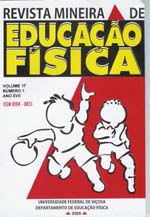ÍNDICE DE FALHAS NAS ATERRISSAGENS DAS ACROBACIAS DE SOLO DE ATLETAS BRASILEIRAS ADULTAS DE GINÁSTICA ARTÍSTICA FEMININA
Keywords:
artistic gymnastics, landing, floor exerciseAbstract
The present study investigated the failure rate in the landings of salto elements during floor exercise of female artistic gymnastics. The data were collected during the senior Brazilian gymnastics championships. 29 senior female gymnasts were observed. The routines were recorded, and analyzed all the landings, using the penalty system of the International Gymnastics Federation’s Code Point. The higher frequency value of deduction was 0.30, corresponding to 6.9%. The diagonal with the highest mean discount on landing was the first, with 0.42 ± 0.09 points. Regarding the number of acrobatic passages, 18 gymnasts showed four and11 made three passes. The gymnasts had failures in 100% of landings, with mean of discount of 1.34 ± 0.04 points in total and mean of discount of 0.36 ± 0.04 points in each diagonal with acrobatic element. The study found significant deficiency in the performance foundation of landing the Brazilian gymnasts.
Downloads
References
BENK, B.T. Análise biomecânica dos fatores de risco de lesões na aterrissagem de ovens atletas de ginástica feminina. Dissertação (Mestrado em Educação Física) – UnB, Brasília, 2013.
CUK, I.; MARINSEK, M. Landing quality in artistic gymnastics is related to landing symmetry. Biology of Sports, Warsaw, v. 30, n. 1, p. 29-33, 2013.
FÉDÉRATION INTERNATIONALE DE GYMNASTIQUE – FIG. Code of point: artistic gymnastics for women. Lausanne, 2013
JOHNSON, B. Stick the landing. Technique Magazine, Indianapolis, v. 29, n. 10, p. 18-19, Nov. 2009.
MARINSEK, M.; CUK, I. Landing errors in teh men’s floor exercise are caused by flight characteristics. Biology of Sports, Warsaw, v. 27, n. 2, p. 123-128, 2010.
MARINSEK, M. Landing characteristics in men’s floor exercise on European championships 2004. Science of Gymnastics Journal, Vancouver, v. 1, n.1, p. 31-39, 2009.
McNITT-GRAY, J. et al. Landing Success Rate During the Artistic Gymnastics Competition of the 2000 Olympic Games: Implications for Improved Gymnast/Mat Interaction. 2013. Disponível em: <http://www.sweatpit.com/forum/ubbthreads.php?ubb=gymnast_land>. Acesso em: 18 ago. 2014
NUNOMURA, M. Análise do treinamento da ginástica artística brasileira. Revista Brasisleira de Ciência do Esporte, Campinas, v. 31, n. 1, p. 25-40, setembro, 2009.
______. Segurança na ginástica olímpica. Motriz, v. 4, n. 2, p. 104-108, 1998.
RUSSELL, K. W. et al. Knee muscle strength in elite male gymnasts. Journal of Orthopaedic and Sports Physical Therapy, v. 22, p. 10-17, 1995.
THOMAS, J. R.; NELSON, J. K. Métodos de pesquisa em atividade física. 3. ed. Porto Alegre: Artmed, 2002.
VANDERLEI, F. M. et al. Características das lesões desportivas e fatores associados com lesão em iniciantes de ginástica artística do sexo feminino. Fisioterapia e Pesquisa, São Paulo, v. 20, n. 2, Abril/junho 2013
Downloads
Published
How to Cite
Issue
Section
License
Os artigos submetidos e publicados são de inteira responsabilidade de seus autores, não refletindo necessariamente a opinião do Comitê Editorial. A revista se reserva o direito de efetuar, nos originais, alterações de ordem normativa, ortográfica e gramatical, com vistas a manter o padrão culto da língua, respeitando, porém, o estilo dos autores. O manuscrito submetido deve ser original, não podendo ter sido publicado em qualquer outro veículo de informação científica, e nem submetido para publicação em outra revista científica. Os trabalhos publicados passam a ser propriedade da revista Mineira de Educação Física, ficando sua reimpressão total ou parcial de acordo com a licença Creative Commons Attibution 4.0. Deve ser consignada a fonte de publicação original. Os originais não serão devolvidos aos autores. As opiniões emitidas pelos autores dos artigos são de sua exclusiva responsabilidade.





 Esta obra está licenciada com uma Licença
Esta obra está licenciada com uma Licença 